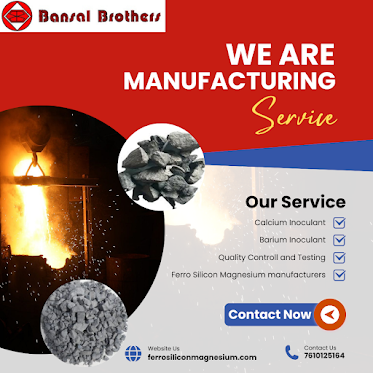Why High Recovery of Ferro Silicon Magnesium Relies on Quality Magnesium Cored Wire Feeders.
- Get link
- X
- Other Apps
In modern metallurgy, the demand for high-quality ferroalloys like ferro silicon magnesium (FeSiMg) is essential, especially in producing high-strength, corrosion-resistant alloys. One of the significant factors that enhance the quality and recovery rates of FeSiMg is the use of a high-quality magnesium cored wire feeder. This article explores how magnesium wire feeders contribute to the high recovery for ferro silicon magnesium and why investing in premium feeders is a strategic advantage for manufacturers.
What is Ferro Silicon Magnesium?
Ferro silicon magnesium is an alloy of iron, silicon, and magnesium that plays a vital role in foundry processes, especially in the production of ductile iron. Its inclusion in metal alloys enhances durability, elasticity, and overall strength, making it highly sought after in industries like automotive, construction, and heavy machinery. Achieving optimal recovery of FeSiMg in the alloying process is crucial because it directly impacts the quality and cost-efficiency of the production.
The Role of Magnesium Cored Wire Feeder
A magnesium cored wire feeder is a specialized device used in the alloying process to introduce magnesium into the molten metal. The cored wire, a tube filled with powdered magnesium, is precisely fed into the molten bath, allowing for controlled and efficient dispersion of magnesium. This method ensures that the magnesium does not oxidize quickly, thus optimizing its incorporation and maximizing recovery rates.
Why Quality Cored Wire Feeders Matter
Using a high-quality magnesium cored wire feeder significantly impacts the recovery of FeSiMg in several ways:
1. Consistent Magnesium Insertion
High-quality cored wire feeders are designed for precision. By controlling the feed rate and insertion depth, they allow for a uniform and consistent introduction of magnesium into the molten metal, preventing waste and ensuring optimal recovery rates. Inconsistent or poorly designed feeders may lead to irregular magnesium distribution, affecting the alloy quality and overall recovery.
2. Enhanced Efficiency and Cost-Effectiveness
Premium feeders are engineered for efficiency, meaning less magnesium is required to achieve the desired FeSiMg composition. This not only reduces material costs but also minimizes waste by ensuring that the maximum amount of magnesium is effectively incorporated into the alloy, resulting in higher recovery rates. Low-grade feeders, on the other hand, can result in inefficient magnesium consumption and higher operational costs.
3. Reduction of Oxidation Losses
One of the primary challenges in the alloying process is preventing magnesium oxidation, which can significantly reduce recovery rates. Quality cored wire feeders are designed to minimize oxidation by controlling the introduction of magnesium precisely and swiftly into the molten metal. By reducing exposure to air, high-quality feeders help prevent magnesium from burning off, thus boosting the recovery of FeSiMg.
4. Durability and Reliability
Investing in a high-quality cored wire feeder translates to long-term durability and reliability. These feeders are built with materials and designs that withstand the high temperatures and demanding conditions of foundries. Low-quality feeders are prone to breakdowns and inconsistent performance, which can interrupt production and impact the recovery of FeSiMg.
5. Improved Control Over Alloy Composition
Consistency is key when producing high-quality alloys. Premium cored wire feeders provide operators with better control over the addition of magnesium, allowing them to maintain specific composition standards in FeSiMg production. This precision contributes to consistent high recovery rates, which is especially beneficial for industries that rely on strict material specifications.
Key Features of Quality Magnesium Cored Wire Feeders
To achieve high recovery rates for ferro silicon magnesium, it’s essential to choose feeders that offer:
- Precision Feed Control: Allows for accurate and consistent magnesium delivery.
- Anti-Oxidation Design: Minimizes air exposure to reduce oxidation losses.
- High-Temperature Resistance: Ensures durability and continuous operation in demanding environments.
- Easy Adjustability: Allows operators to control feed speed and depth for optimal recovery.
- Low Maintenance Requirements: Reduces downtime and keeps costs manageable.
Benefits of High Recovery for FeSiMg Manufacturers
When manufacturers prioritize high recovery for FeSiMg, they benefit in several ways:
- Cost Savings: Reduced magnesium consumption translates to lower material costs.
- Enhanced Product Quality: High-quality FeSiMg improves the overall properties of alloys, making them more desirable for end-users.
- Environmental Impact: Efficient alloy production means less waste and a reduced environmental footprint, which is a growing concern in the industry.
- Competitive Advantage: Companies that consistently produce high-quality alloys with optimized recovery rates gain a competitive edge in the marketplace.
Conclusion
Achieving high recovery for ferro silicon magnesium relies heavily on the quality of magnesium cored wire feeders used in the alloying process. Investing in premium feeders offers greater control, efficiency, and reliability, all of which contribute to superior recovery rates and overall product quality. For manufacturers focused on producing high-grade alloys, a quality magnesium cored wire feeder is an invaluable asset that pays off in improved performance, cost savings, and competitive positioning.
#highrecoveryforferrosiliconmagnesium #magnesiumcoredwirefeeder
- Get link
- X
- Other Apps



Comments
Post a Comment